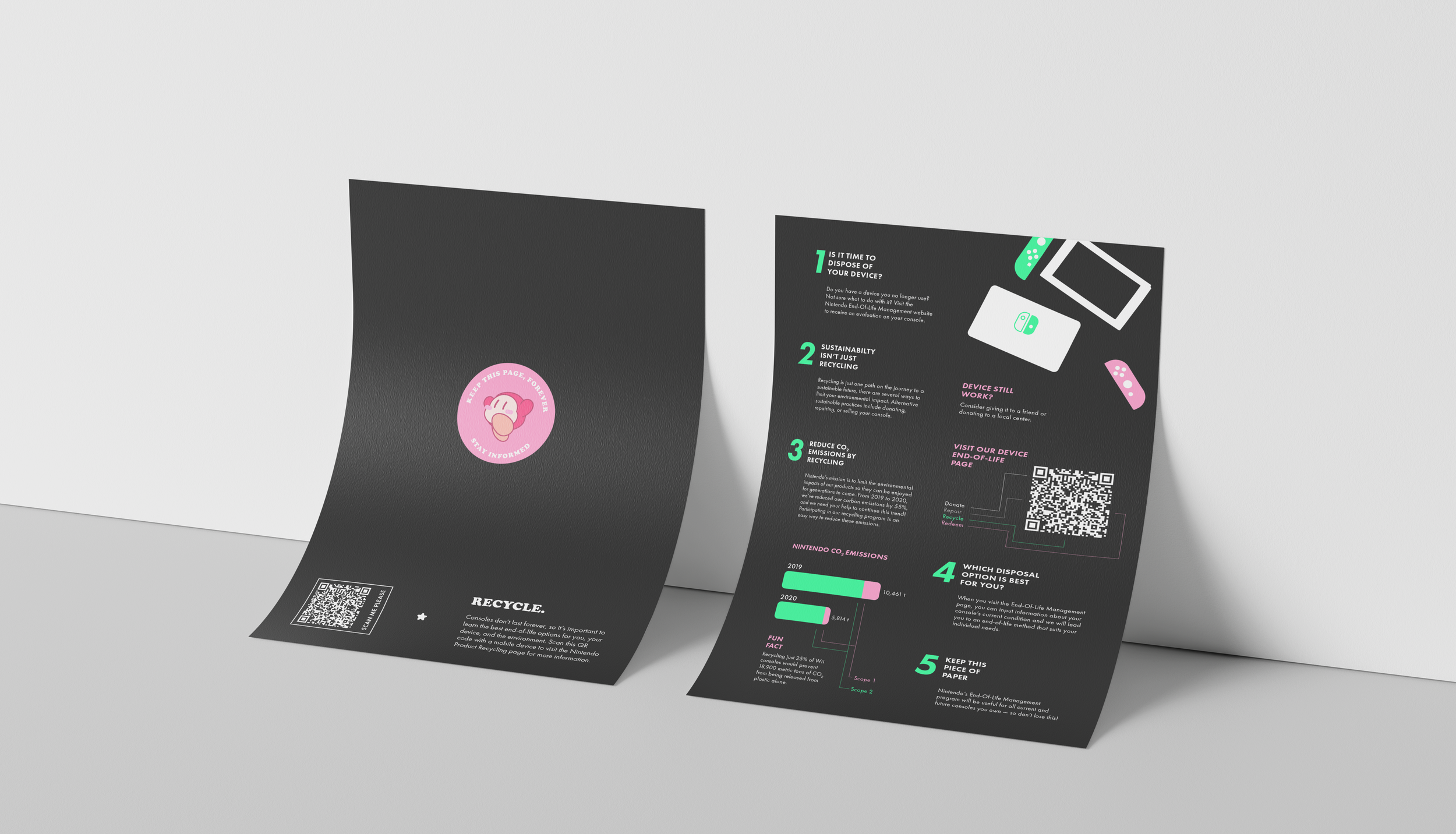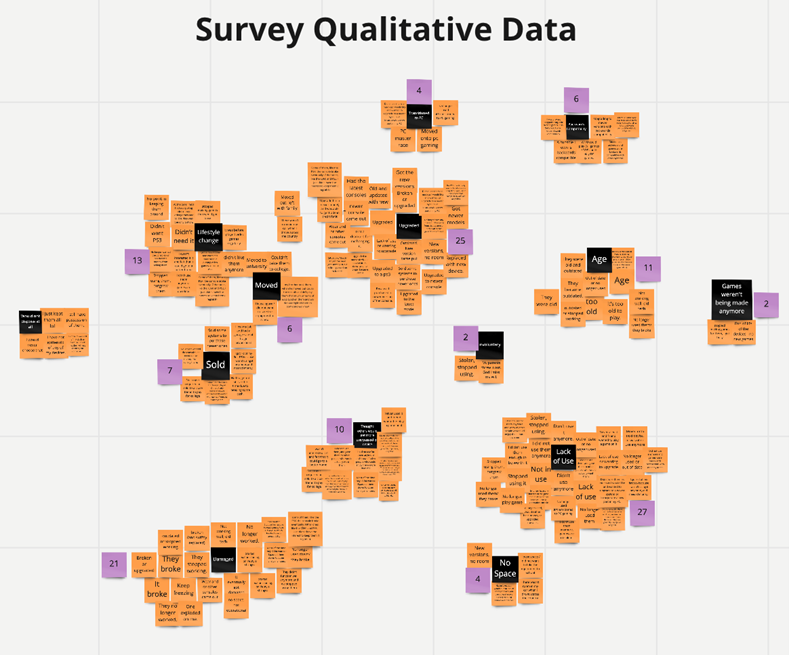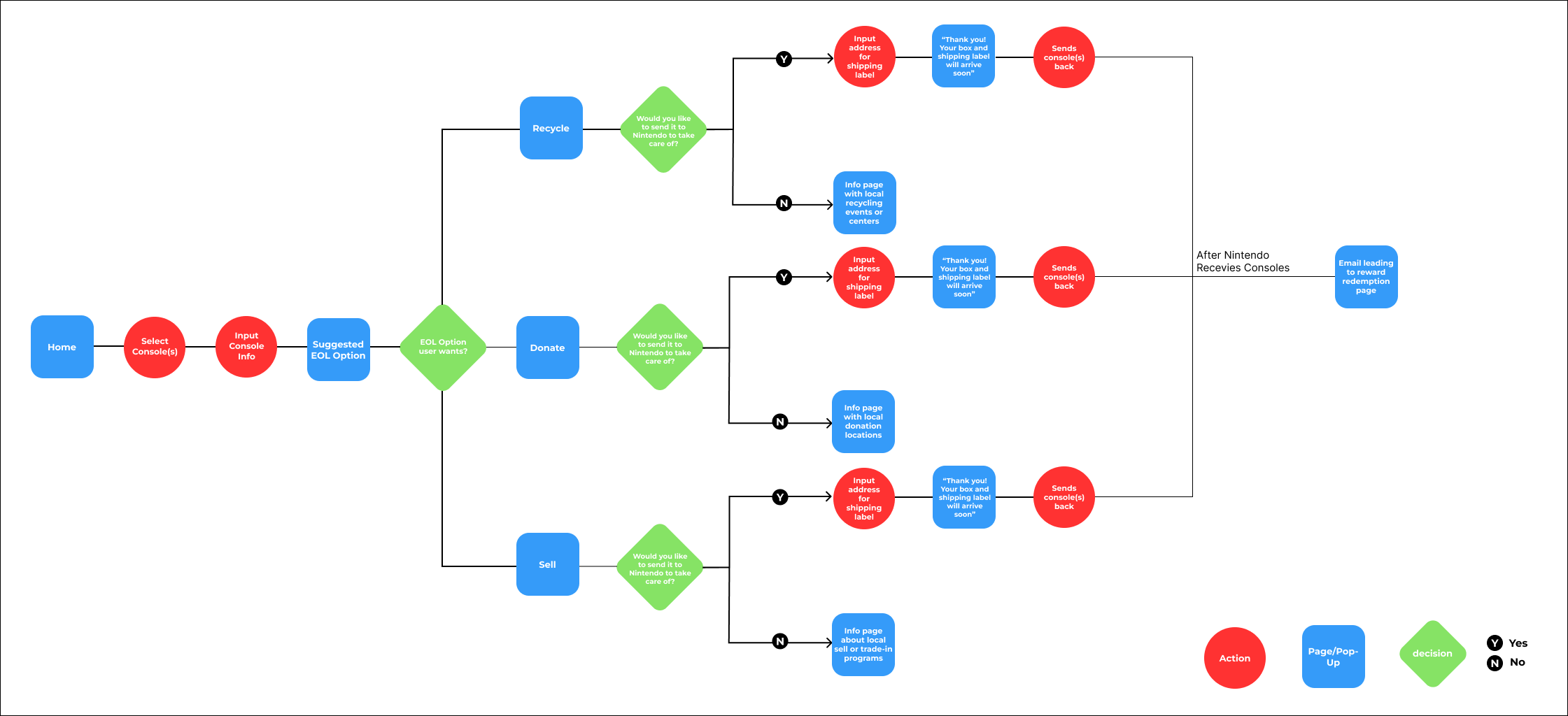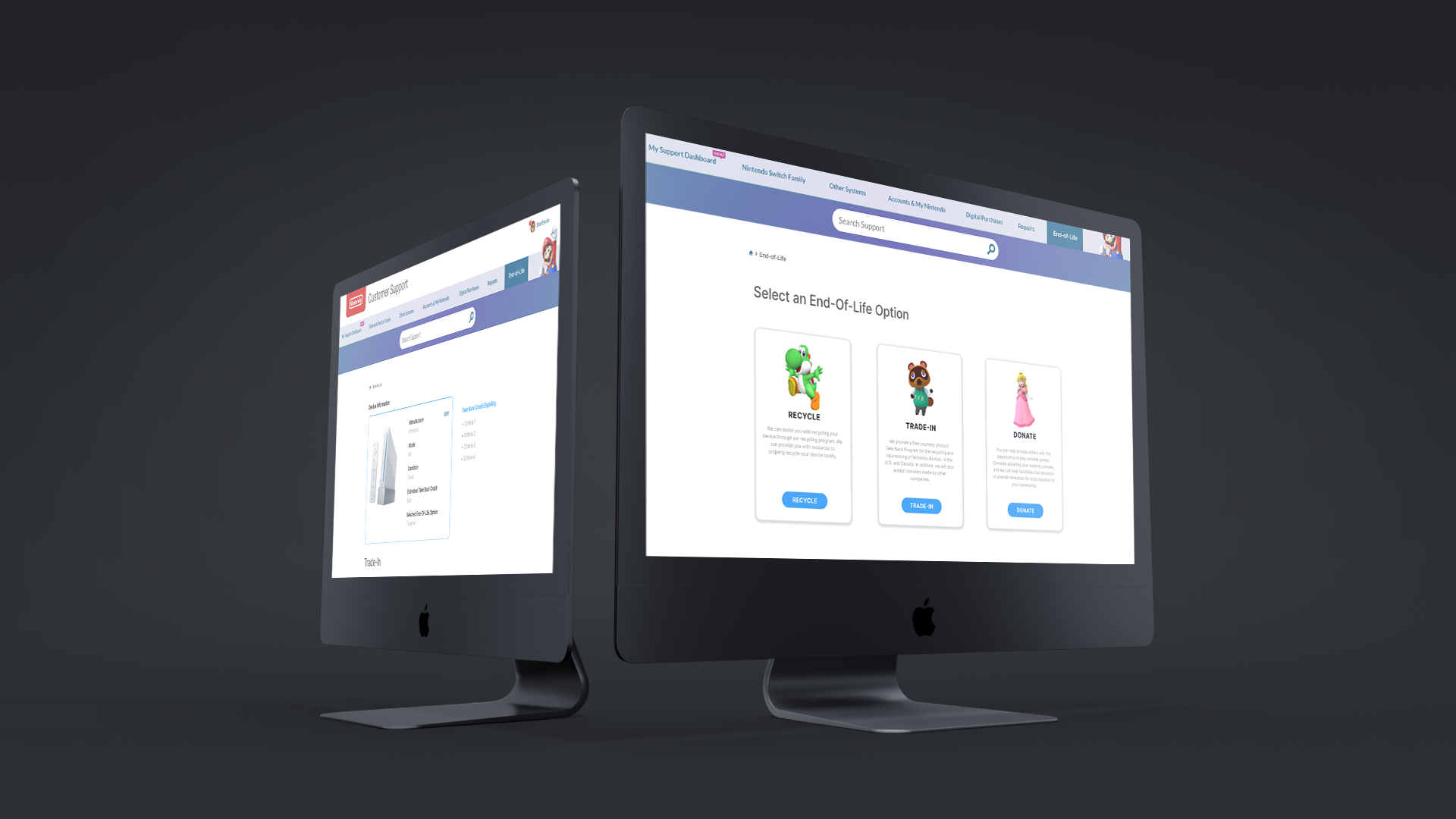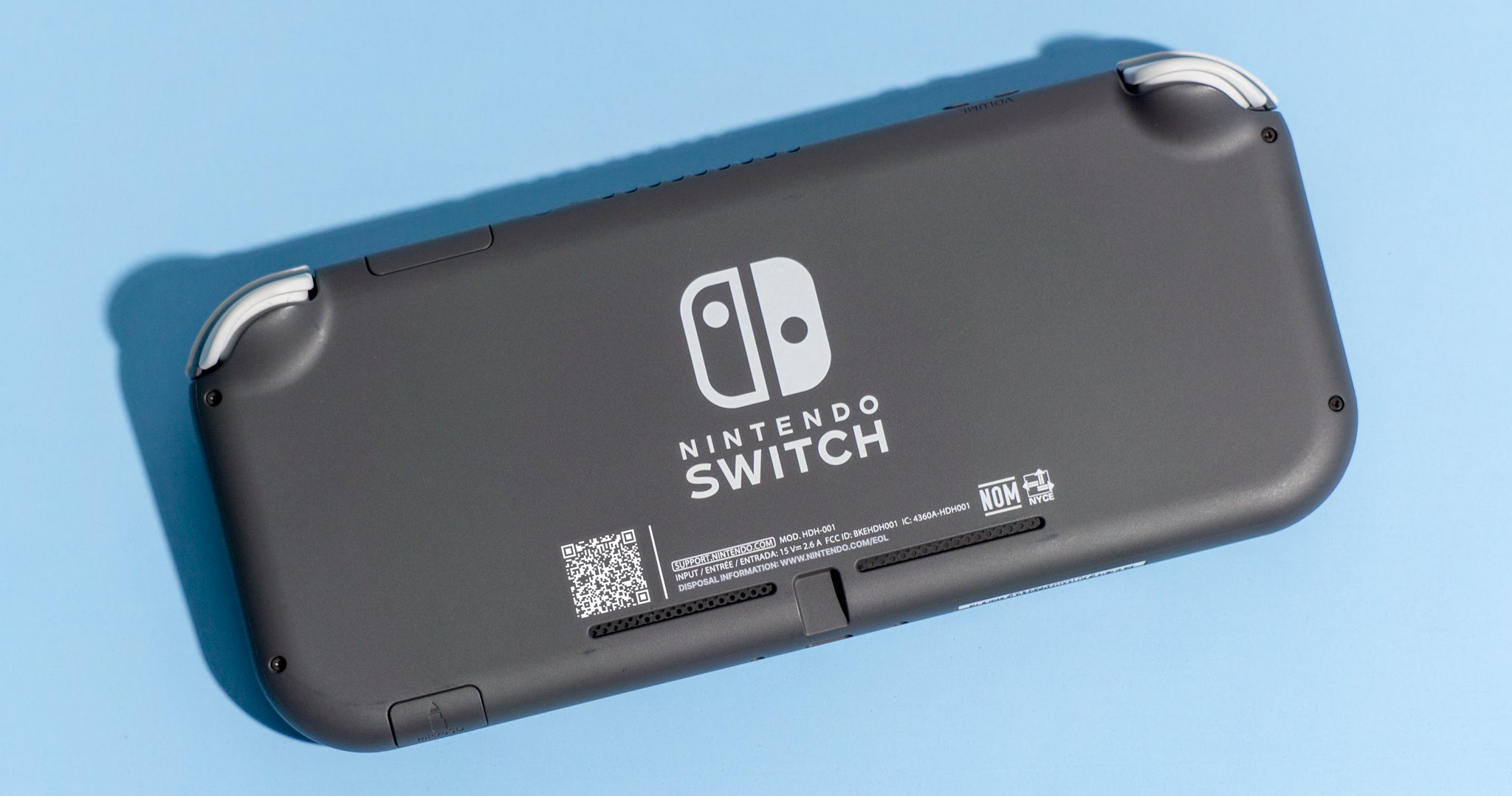2022 / PRODUCT REDESIGN
ROLE
UX Designer
User Researcher
For my Advanced Projects in Human Centered Design & Engineering course, I collaborated with a design team to conduct a sustainability redesign of the Nintendo console disposal process. We redesigned the take-back program website and created a recycling information sheet.
Nintendo Recycling
The Challenge
E-waste continues to act as a major source of pollutants and carbon emissions. Disposed gaming consoles represent a sizable portion of this waste and presents an opportunity for a sustainability redesign. Based on a preliminary impact assessment, if just 25% of sold Wiis were recycled, 18,900 metric tons of CO2 would be prevented from being released.
Objective
Redesign the Nintendo Device Recycling Program to create more sustainable end-of-life options for gaming consoles.
The Process
User research to…
understand how people manage gaming devices they no longer use
understand what impacts user’s gaming console end-of-life decisions
Synthesis to…
generate design recommendations for Nintendo recycling processes
develop user flows and information architecture to map disposal experiences
Prototyping to…
translate findings into sustainability-focused design solutions
User testing to…
evaluate usability and desirability of our prototypes
User Research
Focus
Examine how users manage gaming consoles at the end-of-life stage and investigate what influences their decisions.
Purpose
Identify opportunities to incorporate sustainable practices or design solutions.
Survey
We deployed a survey to gather qualitative and quantitative data with questions centered around what types of gaming consoles participants currently and previously owned, what end-of-life option they had chosen for any consoles they disposed of, and why they chose a disposal method.
User Interviews
Six interviews were conducted remotely with a moderator and a notetaker to expand on survey data, understand the rationale behind why people chose an end-of-life option, how they got rid of their devices, and if they had ever utilized or heard of any recycling programs.
Synthesis
Focus
Analyze survey and interview data to extract themes relating to device disposal and user motivations.
Purpose
Guide design recommendations, user flows, and information architecture to inform future prototypes.
Findings
Qualitative survey data and interview transcripts were analyzed in Miro to develop actionable findings and design recommendations.
Various incentives influence End-of-life option decision. Incentives and motives, in this case, could be money, to help family or friends, or get credit that can be used to buy new consoles.
Console Disposal is Emotional. One participant stated, “I kept my Nintendo 64 and Super Nintendo for years and years. I felt odd getting rid of it because it was such an old console and I thought they were cool. The nostalgia of keeping it was the main reason why I never sold or disposed of it...”
User anticipated future use for their consoles. 22% of survey respondents indicated that potential future use or selling affected their console end-of-life decision.
Users know that e-waste is harmful but don’t know how to dispose of devices sustainably. 88% of our survey respondents were not aware of any recycling programs and resorted to other end-of-life options for their consoles
User flows and Information architecture
We drafted user flows to ensure our design matched the user’s cognitive model extracted from our user research. This also allowed us to further narrow the scope of our project and consider which features were necessary.
Rough user flow
Information architecture
Design recommendations
Based on our findings, our Nintendo recycling program redesign should consider the following recommendations:
Provide incentive to motivate users to dispose of their consoles in a sustainable manner
Limit any emotional burden users go through when disposing of consoles in order to provide the best end-of-life process
Outline numerous, sustainable end-of-life options so users can decide what’s best for them and their console
Emphasize transparency on how and where to recycle, donate, or trade in devices
Prototyping
We developed four prototypes:
a redesign of the current Nintendo Product Recycling website
a physical recycling information sheet to include in console packaging
a mockup of disposal information on the back of the Nintendo Switch console
a reminder email system for new and existing Nintendo account owners.
Take-back website redesign
Goal: provide comprehensive information on the device end-of-life options in an intuitive, efficient, and transparent process.
Flow:
Homepage provides information on Nintendo's services with assisting in End-of-Life, detailing the process and explaining rewards.
Users inputting device model and condition information.
Based on the console condition, users will be presented with end-of-life options that best match their console.
Users receive disposal instructions and compensation options.
Recycling information sheet
Goal: address the inaccessibility of recycling information with a physical sheet to be included in console packaging
Features:
Outline of Nintendo take-back program and other device end-of-life options
QR code to take-back program website
Sensitive, reassuring language and overall transparency of the disposal process
Collectible art to encourage retention of the sheet
End-of-life information on console
Goal: Ensure access to recycling information when devices are given to friends or donated.
Features:
Link and QR code to take-back program website
Discreet yet legible text to avoid interference with Nintendo design aesthetic
Front and back of recycling information sheet
Mockup of recycling information on back of Nintendo Switch console
Take-back website device information and disposal option screens
User testing
Focus
Evaluated website redesign for usability and recycling sheet for desirability.
Purpose
Ensure solutions match user needs while encouraging sustainable practices.
Findings
We conducted four interviews and moderated user tests. Evaluation yielded valuable results for the website redesign, recycling sheet, and email reminders. After analyzing key points from the evaluation sessions, we developed four usability findings and desirability findings:
Text is too small and information dense. Several participants mentioned that text descriptions for end-of life options were too small.
Incentives are unclear. Participants were unsure of which disposal options provided which types of compensation.
Navigation is intuitive. Despite issues with excessive text and unclear compensation, participants describe the navigation of the site as intuitive and logical.
Users would use our prototypes. As reflected in our user research, every participant agreed that sustainability alone is strong enough motivator to recycle, they simply did not know of any resources to do so.
Long-term usability study
Given more time for long term usability study, we would evaluate the take-back redesign and recycling information sheet as artifacts that encourage sustainability through design. Therefore, the evaluation aims to measure behavior change in relation to gaming console recycling habits. This would be achieved through interview studies that can expose “impact ripples”, or how user’s attitudes and knowledge recycling options have changed before vs. after the program was introduced.
Future Iterations
Based on our usability tests and desirability interviews, we would further iterate on our prototype in the following ways if we continued this project.
Take-Back Program Website Redesign. Reduce both the amount and density of text to ensure relevant information is quickly conveyed. Text size will also be increased to improve legibility.
End-of-Life Information Sheet. Information sheet will be revised to include clearer information about the take-back program. Compensation information will be highlighted to encourage users to visit the redesigned website.
End-of-Life Information on Console. The website URL will be relabeled as “Recycling Information” and a brief summary of the take-back program will be added to ensure the purpose and goal of the program are clear to users.
Conclusions and Reflection
Despite the scope readjustments due to the lack of recycling data, our Nintendo take-back program redesign produced several artifacts that will encourage sustainable behavior in gaming console users. From the results of the impact assessment and usability testing, the take-back program website redesign, information sheet, on-console take-back information and email reminder will stimulate measurable reductions in carbon emissions.
This was my first product redesign focused on sustainability, so it was a tremendous learning experience working through impact assessments and eventually new methods for evaluation. Sustainable HCI technologies present a unique challenge during evaluation since our product and it's effects don't exist, and it was quite exciting trying to devise methods like service blueprints and impact ripple studies to approach this problem space.
